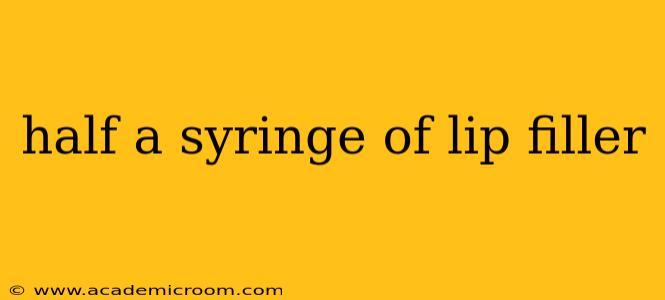Half a Syringe of Lip Filler: What You Need to Know
Considering lip fillers? Understanding the implications of using half a syringe, versus a full one, is crucial for achieving natural-looking and satisfying results. This guide will explore the nuances of lip filler volume, helping you make an informed decision.
What does half a syringe of lip filler actually mean?
The amount of filler in a syringe varies depending on the brand and type. A standard syringe typically contains 1ml of filler. "Half a syringe" therefore usually refers to approximately 0.5ml. However, it's important to consult with your injector, as they may use different sized syringes or adjust the amount based on your specific needs and desired outcome. Don't rely solely on the "half syringe" description; discuss your goals clearly with your practitioner.
Is half a syringe enough for lip augmentation?
Whether half a syringe is enough depends entirely on your individual lip anatomy, desired outcome, and the type of filler used. Some people may see significant enhancement with half a syringe, while others might require more for noticeable results. Factors such as lip thinness, existing volume, and the desired level of fullness will all influence the amount needed.
What are the benefits of using half a syringe?
Using a smaller amount of filler like half a syringe offers several potential advantages:
- Lower cost: A smaller amount naturally translates to a lower price point.
- Less swelling and bruising: Smaller injections generally lead to less trauma to the tissue, potentially reducing post-treatment swelling and bruising.
- Gradual enhancement: It allows for a more gradual approach to lip augmentation, letting you assess results before adding more filler in subsequent sessions. This is particularly helpful if you're unsure of the desired level of fullness.
- Reduced risk of complications: Less filler means a reduced risk of complications such as filler migration or nodule formation, though these are relatively rare with skilled injectors.
What are the drawbacks of using only half a syringe?
While using half a syringe can be beneficial, it's important to be aware of potential drawbacks:
- Subtle results: You may not achieve the dramatic lip enhancement you desire with a smaller amount of filler. The results might be subtle or less noticeable than expected.
- Multiple sessions needed: You may need multiple treatments to achieve your desired fullness, leading to increased overall cost and potential downtime.
- Uneven results: An insufficient amount of filler might result in an uneven lip appearance. A skilled injector will mitigate this risk, but it's still a possibility.
How much does half a syringe of lip filler cost?
The cost of lip filler varies considerably depending on factors like the type of filler used, the injector's experience and location, and the amount of filler used. While it’s impossible to give a precise price, you should expect to pay significantly less than the cost of a full syringe. Always obtain a quote from your chosen practitioner before proceeding with any treatment.
How long does half a syringe of lip filler last?
The longevity of lip fillers depends on several factors, including the type of filler, your body's metabolism, and your lifestyle. Hyaluronic acid fillers, the most common type, typically last anywhere from 6 to 12 months. Even with half a syringe, the duration is still comparable to a full syringe; the amount of filler doesn't significantly impact its longevity.
Ultimately, the decision of whether half a syringe of lip filler is right for you should be made in consultation with a qualified and experienced medical professional. They can assess your facial anatomy, discuss your aesthetic goals, and recommend the appropriate amount of filler for optimal, safe, and natural-looking results. Remember, choosing a skilled injector is paramount for achieving the best possible outcome and minimizing potential risks.
